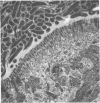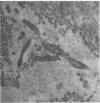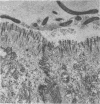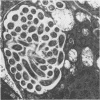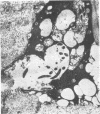Abstract
The large intestines of pigs with swine dysentery were examined by phase, light, and electron microscopy at intervals up to 11 days after oral inoculation with mucosal scrapings from infected pigs. Large spirochetes with the structural characteristics of Treponema hyodysenteriae were found only in infected pigs and were first observed in small numbers in the lumen of the large intestine 2 days after inoculation. Numerous large spirochetes were present on the luminal surface and in mucosal crypts as lesions developed. Degenerative changes were first observed in the apical portion of epithelial cells in close contact with large spirochetes. These large spirochetes were found intact in goblet cells and epithelial cells in the early stages of the disease and were numerous within degenerating epithelial cells as lesions became more advanced. Invasion beyond the lamina propria was not detected. These observations demonstrated the relationship between pathogenic large spirochetes and the mucosa of the large intestine in a specific disease, swine dysentery.
Full text
PDF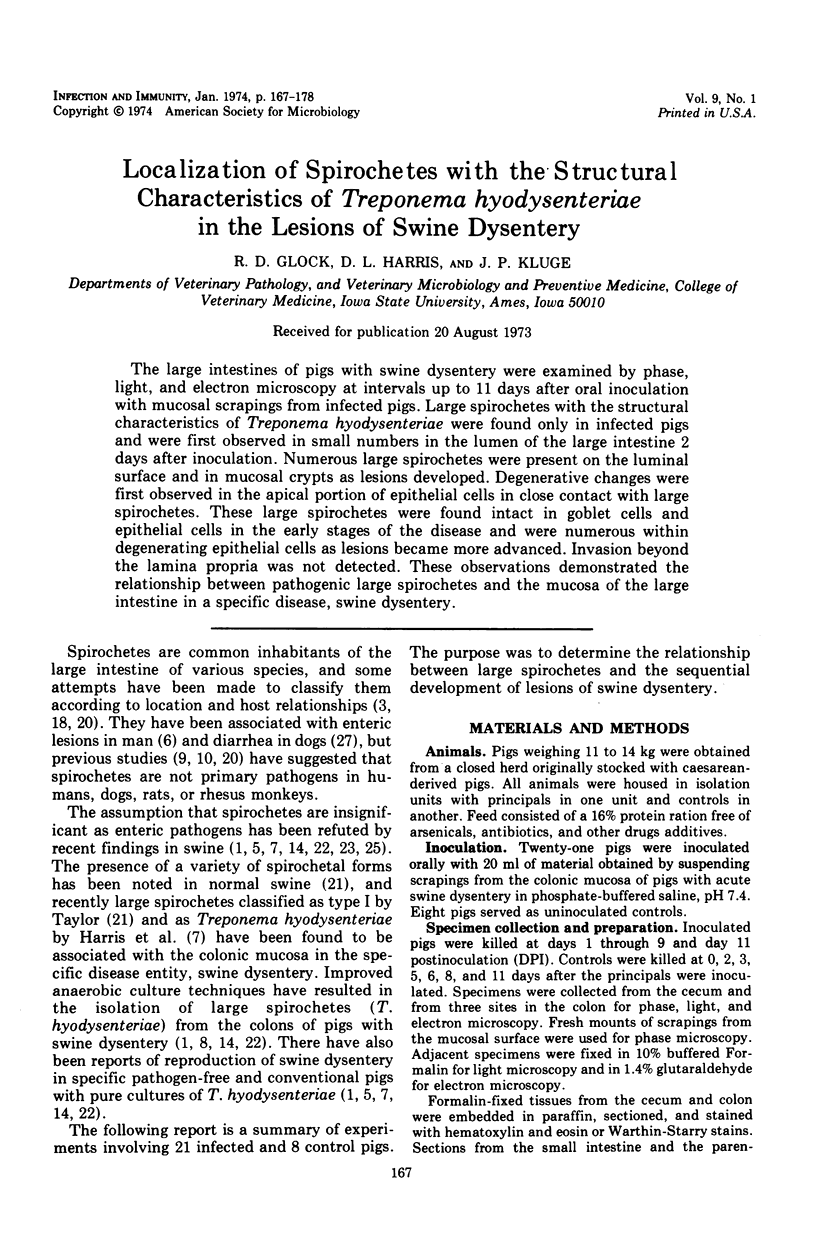
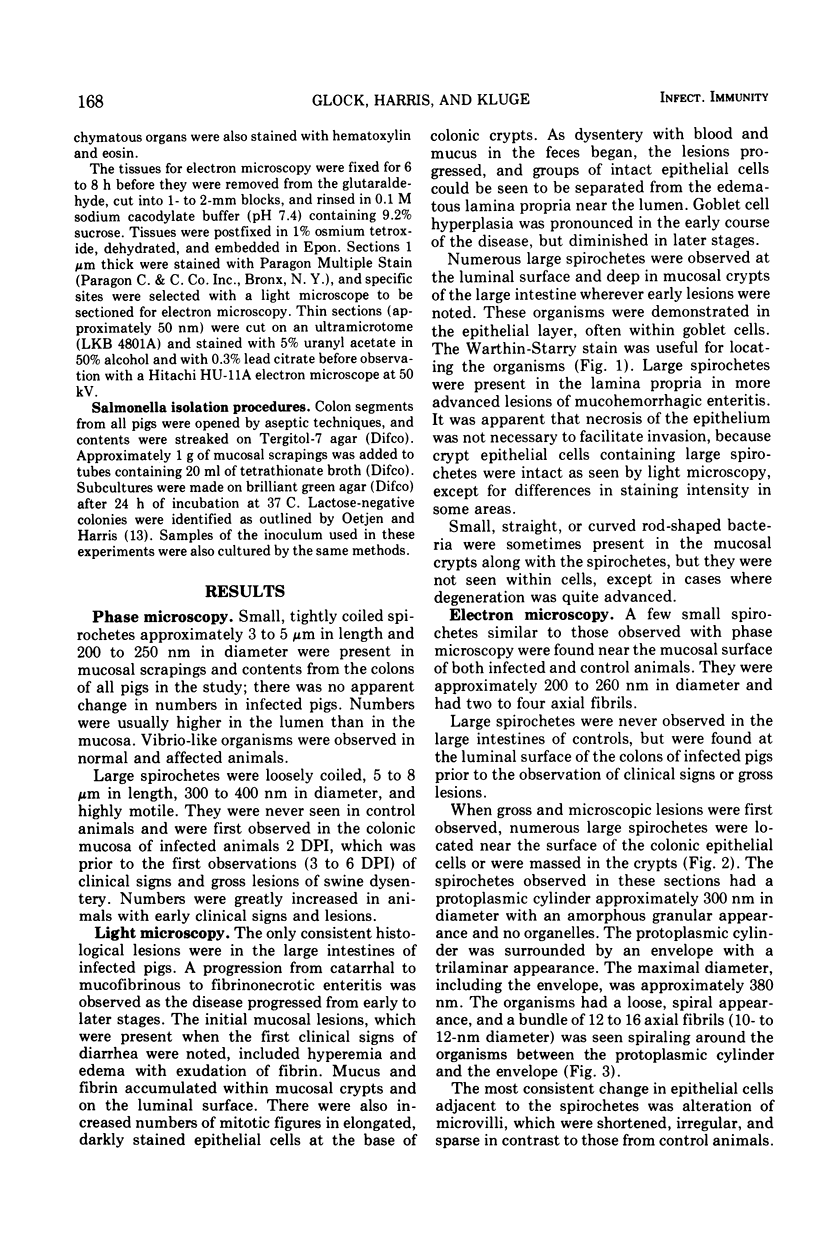
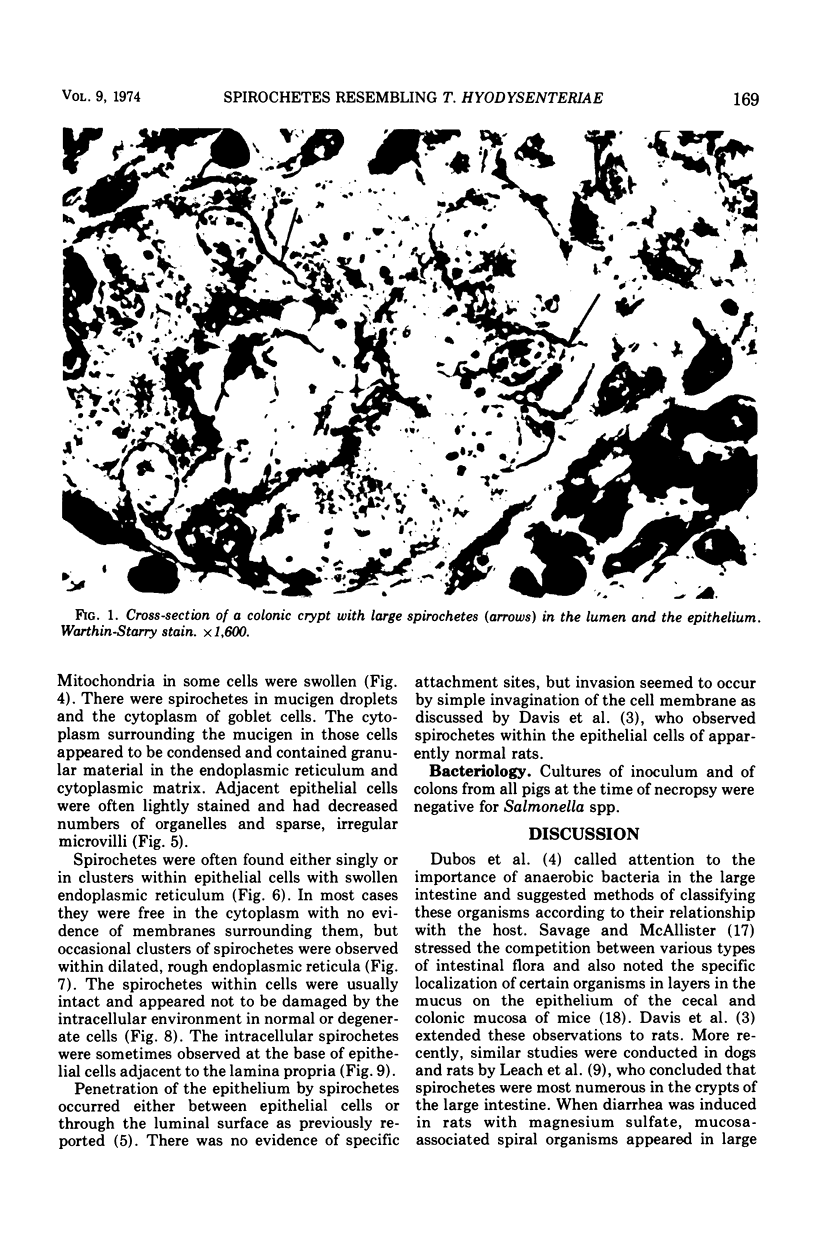
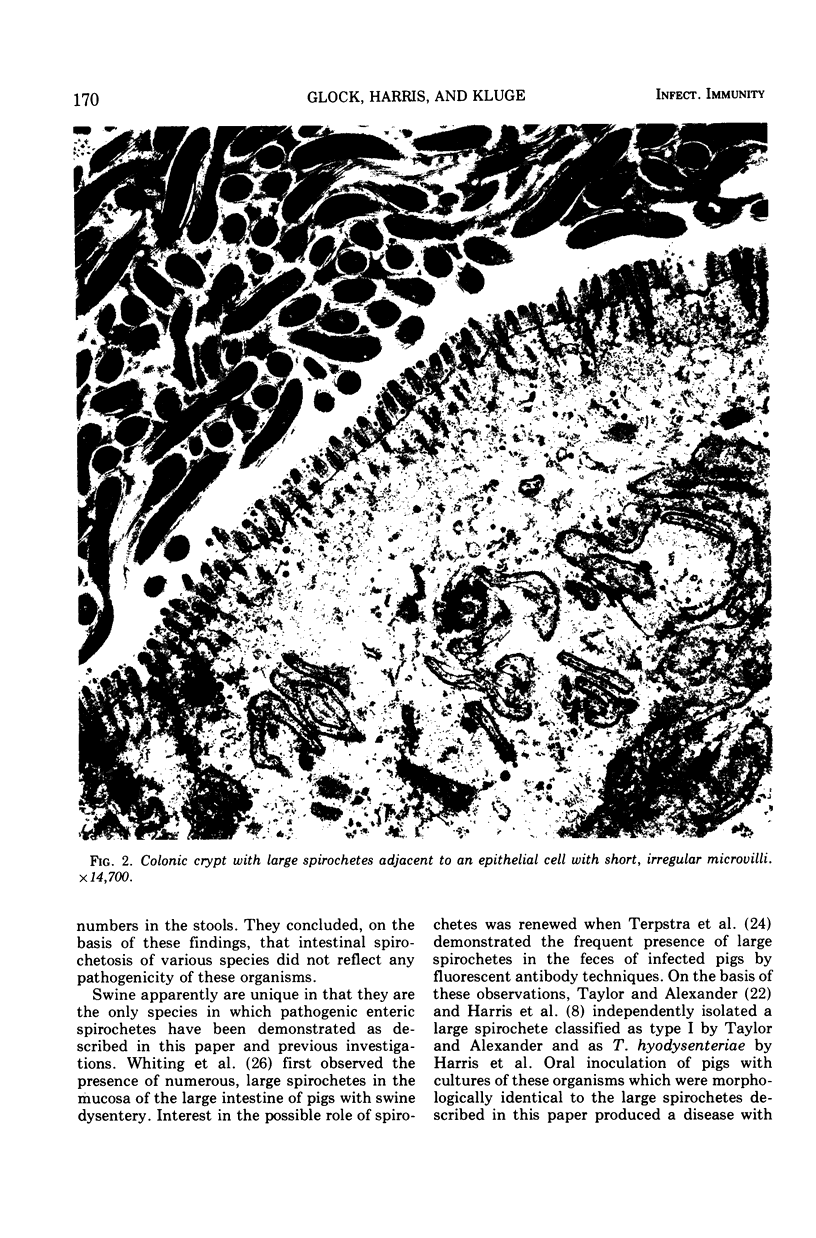
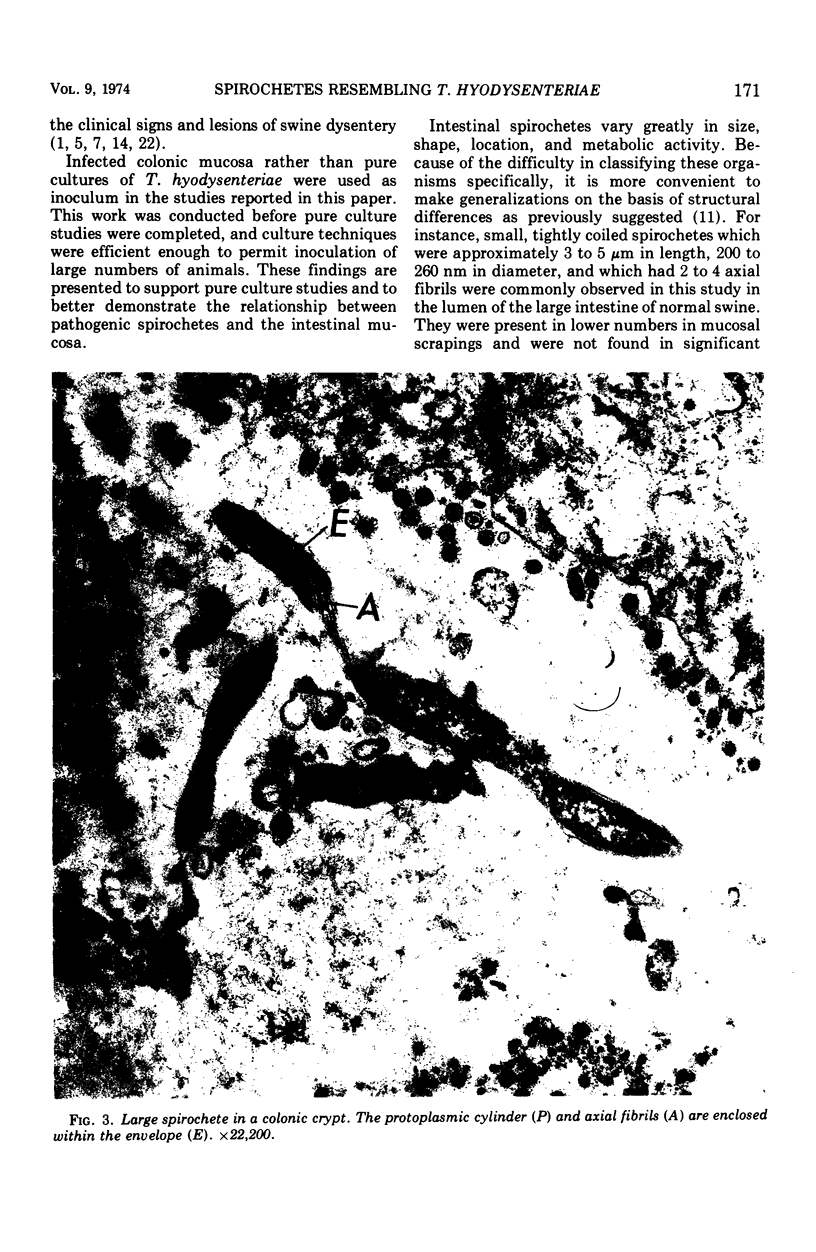
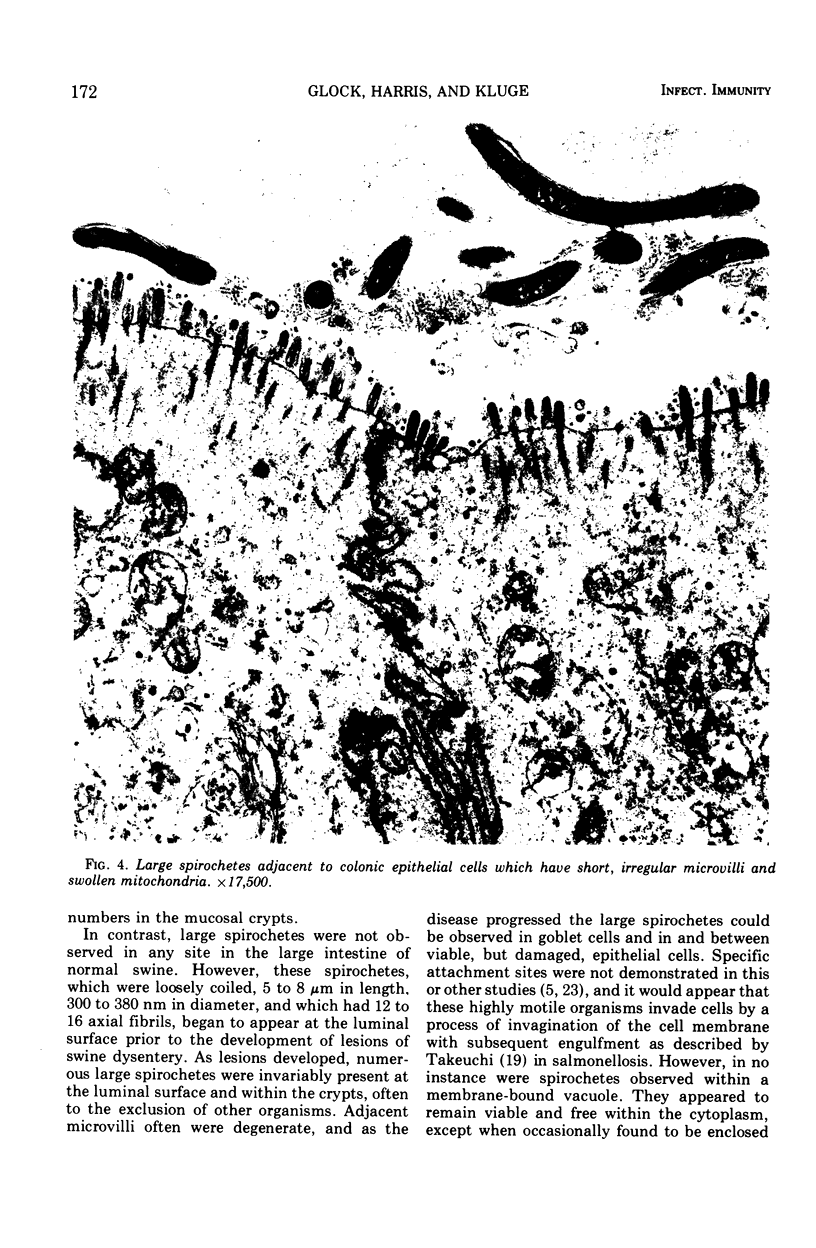
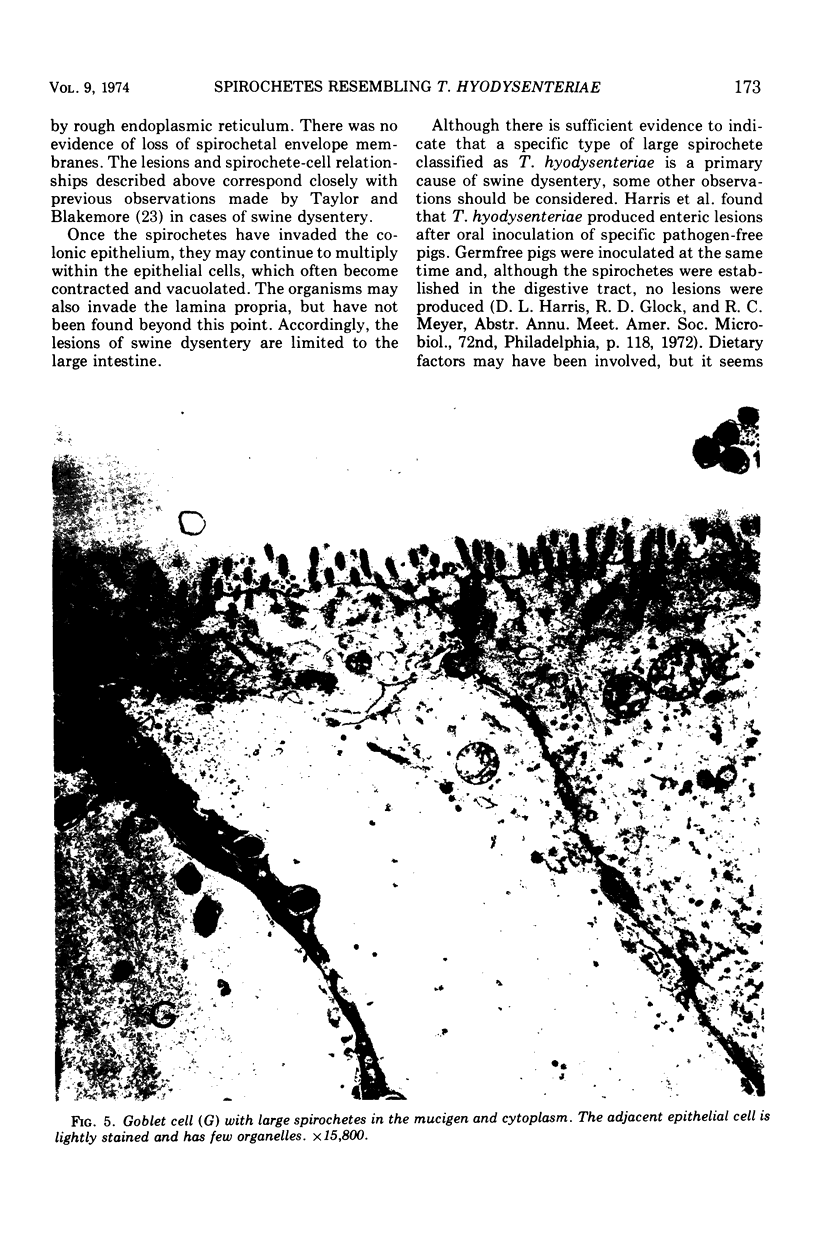
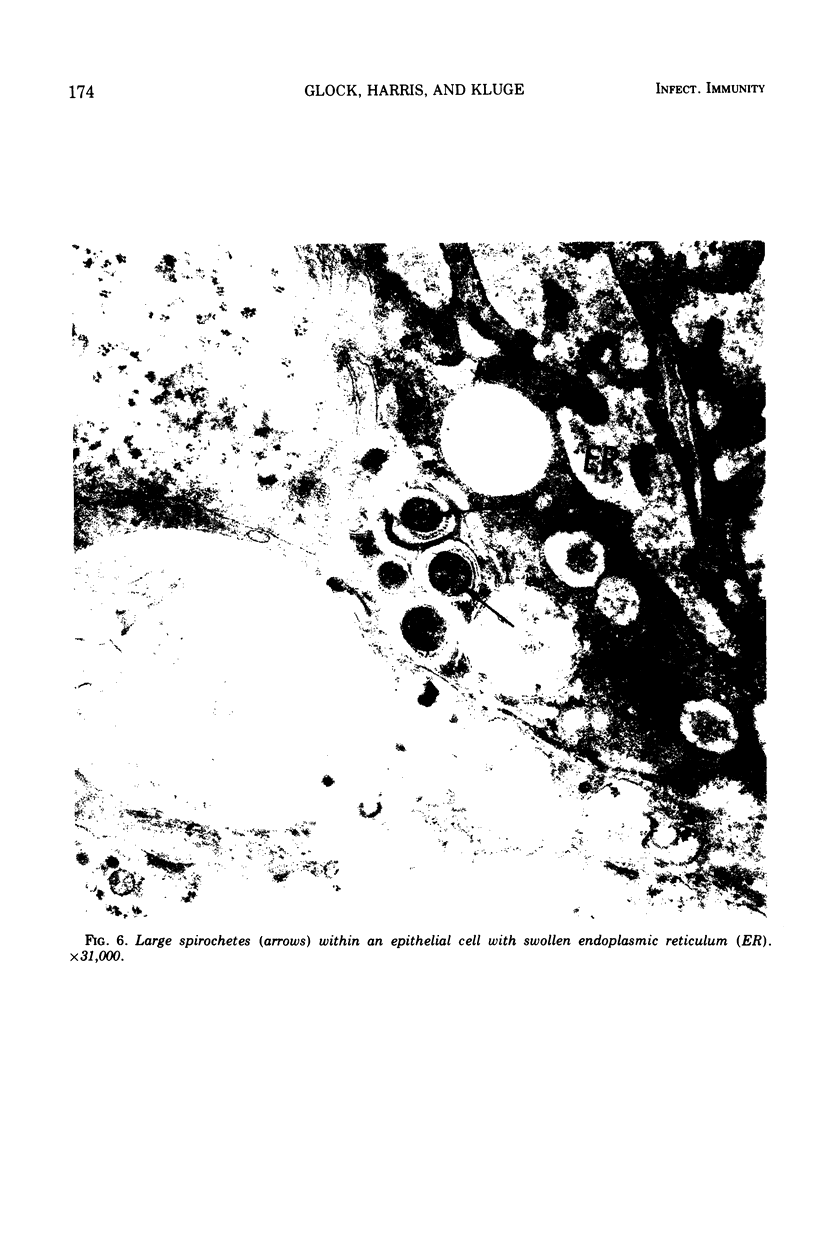
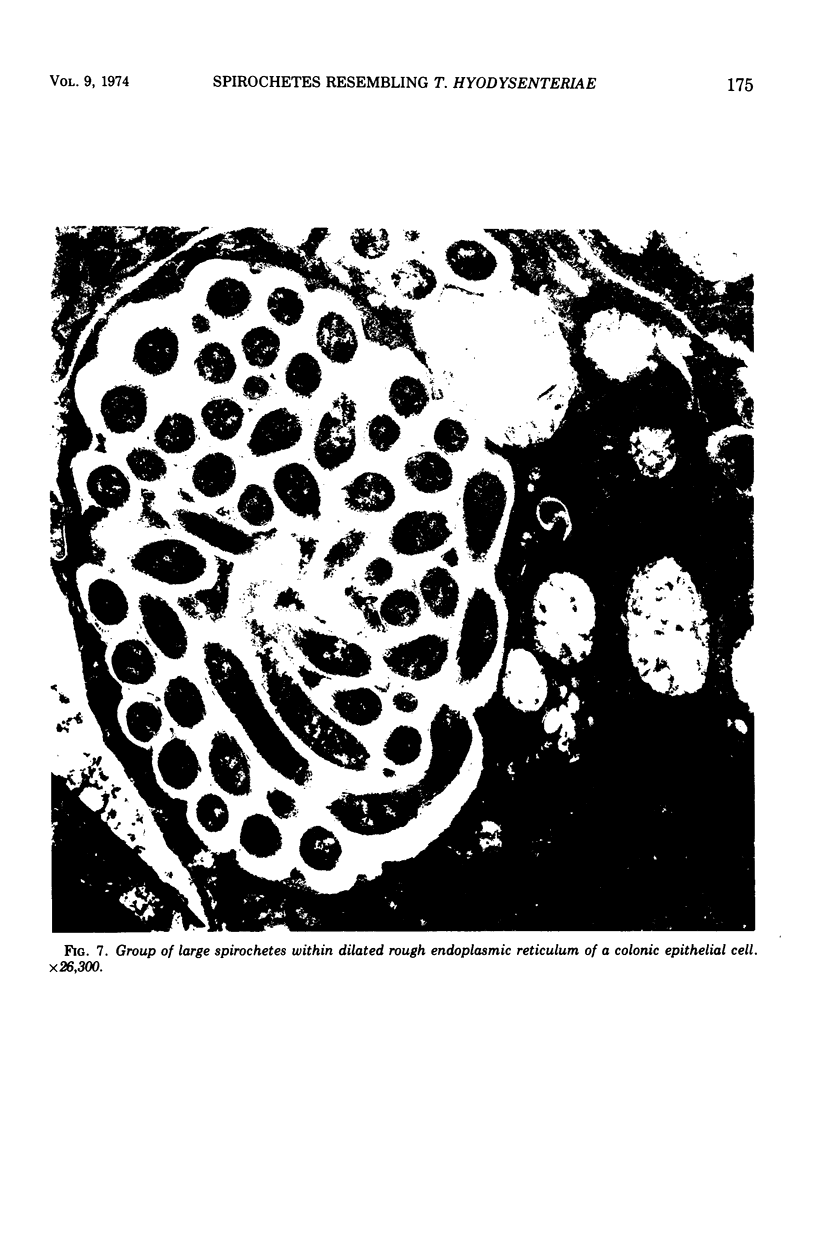

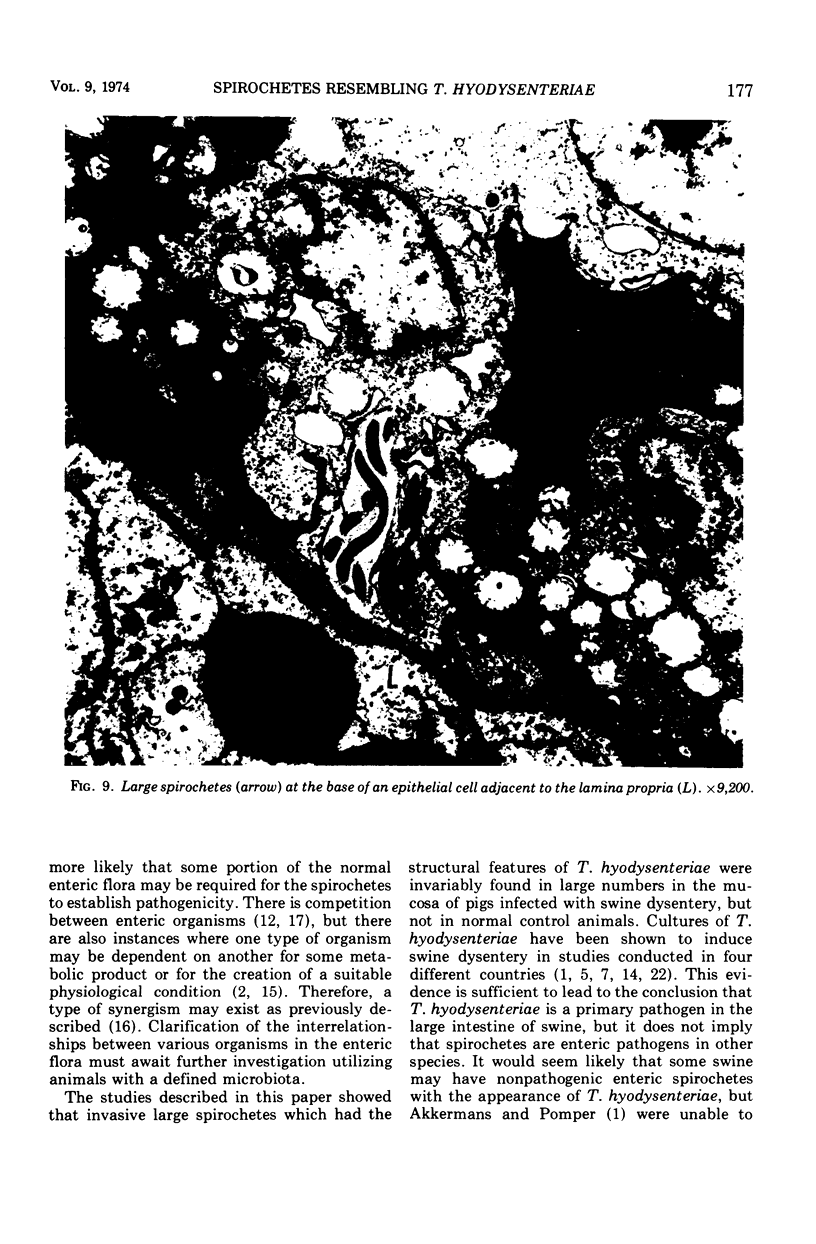
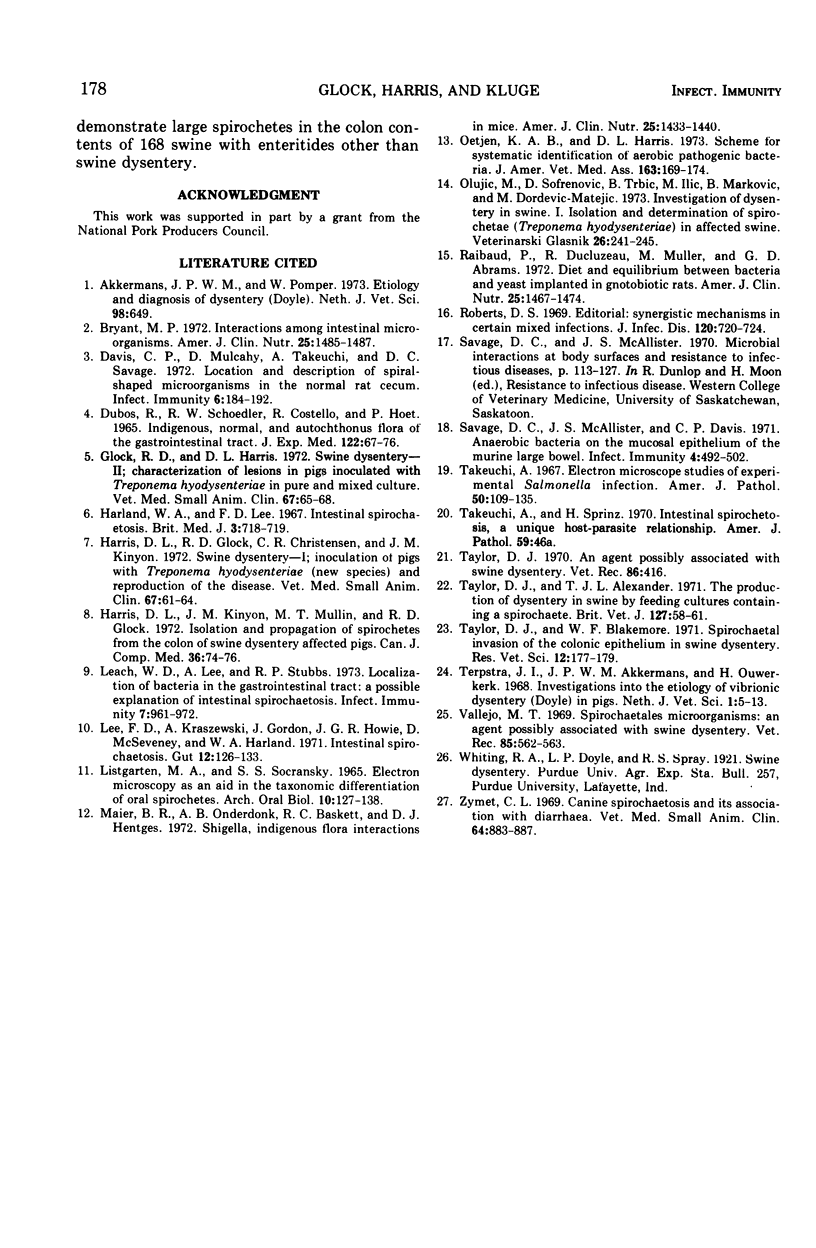
Images in this article
Selected References
These references are in PubMed. This may not be the complete list of references from this article.
- Akkermans J. P., Pomper W. Aetiology and diagnosis of swine dysentery (Doyle). Tijdschr Diergeneeskd. 1973 Jul 15;98(14):649–654. [PubMed] [Google Scholar]
- Bryant M. P. Interactions among intestinal microorganisms. Am J Clin Nutr. 1972 Dec;25(12):1485–1487. doi: 10.1093/ajcn/25.12.1485. [DOI] [PubMed] [Google Scholar]
- DUBOS R., SCHAEDLER R. W., COSTELLO R., HOET P. INDIGENOUS, NORMAL, AND AUTOCHTHONOUS FLORA OF THE GASTROINTESTINAL TRACT. J Exp Med. 1965 Jul 1;122:67–76. doi: 10.1084/jem.122.1.67. [DOI] [PMC free article] [PubMed] [Google Scholar]
- Davis C. P., Mulcahy D., Takeuchi A., Savage D. C. Location and description of spiral-shaped microorganisms in the normal rat cecum. Infect Immun. 1972 Aug;6(2):184–192. doi: 10.1128/iai.6.2.184-192.1972. [DOI] [PMC free article] [PubMed] [Google Scholar]
- Glock R. D., Harris D. L. Swine dysentery. II. Characterization of lesions in pigs inoculated with Treponema hyodysenteriae in pure and mixed culture. Vet Med Small Anim Clin. 1972 Jan;67(1):65–68. [PubMed] [Google Scholar]
- Harland W. A., Lee F. D. Intestinal spirochaetosis. Br Med J. 1967 Sep 16;3(5567):718–719. doi: 10.1136/bmj.3.5567.718. [DOI] [PMC free article] [PubMed] [Google Scholar]
- Harris D. L., Glock R. D., Christensen C. R., Kinyon J. M. Inoculation of pigs with Treponema hyodysenteriae (new species) and reproduction f the disease. Vet Med Small Anim Clin. 1972 Jan;67(1):61–64. [PubMed] [Google Scholar]
- Harris D. L., Kinyon J. M., Mullin M. T., Glock R. D. Isolation and propagation of spirochetes from the colon of swine dysentery affected pigs. Can J Comp Med. 1972 Jan;36(1):74–76. [PMC free article] [PubMed] [Google Scholar]
- LISTGARTEN M. A., SOCRANSKY S. S. ELECTRON MICROSCOPY AS AN AID IN THE TAXONOMIC DIFFERENTIATION OF ORAL SPIROCHETES. Arch Oral Biol. 1965 Jan-Feb;10:127–138. doi: 10.1016/0003-9969(65)90064-6. [DOI] [PubMed] [Google Scholar]
- Leach W. D., Lee A., Stubbs R. P. Localization of bacteria in the gastrointestinal tract: a possible explanation of intestinal spirochaetosis. Infect Immun. 1973 Jun;7(6):961–972. doi: 10.1128/iai.7.6.961-972.1973. [DOI] [PMC free article] [PubMed] [Google Scholar]
- Lee F. D., Kraszewski A., Gordon J., Howie J. G., McSeveney D., Harland W. A. Intestinal spirochaetosis. Gut. 1971 Feb;12(2):126–133. doi: 10.1136/gut.12.2.126. [DOI] [PMC free article] [PubMed] [Google Scholar]
- Maier B. R., Onderdonk A. B., Baskett R. C., Hentges D. J. Shigella, indigenous flora interactions in mice. Am J Clin Nutr. 1972 Dec;25(12):1433–1440. doi: 10.1093/ajcn/25.12.1433. [DOI] [PubMed] [Google Scholar]
- Oetjen K. A., Harris D. L. Scheme for systematic identification of aerobic pathogenic bacteria. J Am Vet Med Assoc. 1973 Jul 15;163(2):169–175. [PubMed] [Google Scholar]
- Raibaud P., Ducluzeau R., Muller M. C., Abrams G. D. Diet and the equilibrium between bacteria and yeast implanted in gnotobiotic rats. Am J Clin Nutr. 1972 Dec;25(12):1467–1474. doi: 10.1093/ajcn/25.12.1467. [DOI] [PubMed] [Google Scholar]
- Roberts D. S. Synergic mechanisms in certain mixed infections. J Infect Dis. 1969 Dec;120(6):720–724. doi: 10.1093/infdis/120.6.720. [DOI] [PubMed] [Google Scholar]
- Savage D. C., McAllister J. S., Davis C. P. Anaerobic bacteria on the mucosal epithelium of the murine large bowel. Infect Immun. 1971 Oct;4(4):492–502. doi: 10.1128/iai.4.4.492-502.1971. [DOI] [PMC free article] [PubMed] [Google Scholar]
- Takeuchi A. Electron microscope studies of experimental Salmonella infection. I. Penetration into the intestinal epithelium by Salmonella typhimurium. Am J Pathol. 1967 Jan;50(1):109–136. [PMC free article] [PubMed] [Google Scholar]
- Taylor D. J., Alexander T. J. The production of dysentery in swine by feeding cultures containing a spirochaete. Br Vet J. 1971 Nov;127(11):58–61. doi: 10.1016/s0007-1935(17)37282-2. [DOI] [PubMed] [Google Scholar]
- Taylor D. J., Blakemore W. F. Spirochaetal invasion of the colonic epithelium in swine dysentery. Res Vet Sci. 1971 Mar;12(2):177–179. [PubMed] [Google Scholar]
- Vallejo M. T. Spirochaetales micro-organisms: an agent possibly associated with swine dysentery. Vet Rec. 1969 Nov 15;85(20):562–563. doi: 10.1136/vr.85.20.562. [DOI] [PubMed] [Google Scholar]
- Zymet C. L. Canine spirochetosis and its association with diarrhea. Vet Med Small Anim Clin. 1969 Oct;64(10):883–887. [PubMed] [Google Scholar]




